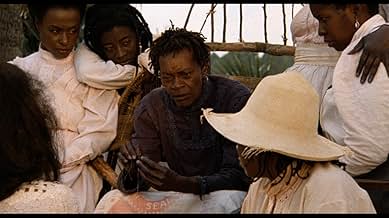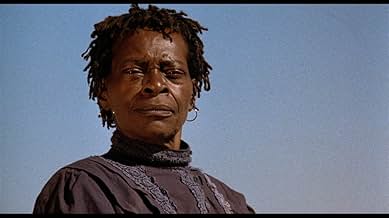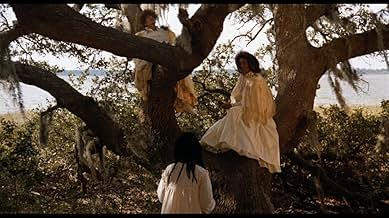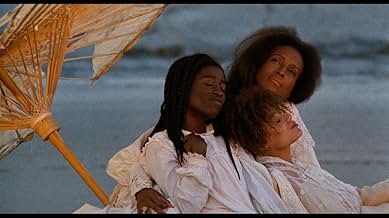NOTE IMDb
6,6/10
3,6 k
MA NOTE
Ajouter une intrigue dans votre langueA languid, impressionistic story of three generations of Gullah women living on the South Carolina Sea Islands in 1902.A languid, impressionistic story of three generations of Gullah women living on the South Carolina Sea Islands in 1902.A languid, impressionistic story of three generations of Gullah women living on the South Carolina Sea Islands in 1902.
- Réalisation
- Scénario
- Casting principal
- Récompenses
- 4 victoires et 2 nominations au total
Barbara O
- Yellow Mary
- (as Barbara-O)
Tony King
- Newlywed Man
- (as Malik Farrakhan)
Avis à la une
It's tough to sort my feelings on Daughters of the Dust. The film is built around a compelling and often forgotten segment of black history that maintains social resonance beyond its time and place; director Julie Dash deserves credit for capturing the emotion and pain of cultural transformation, and there are lovely images throughout. But Daughters of the Dust makes very little effort to engage the audience: it's difficult to maintain a sense of each character's individual goals, and the film often sacrifices narrative momentum for visual poetry. Unfortunately, I'm left with a film that interests me more in theory than in practice. -TK 9/30/10
Julie Dash grew up in Long Island, New York and graduated from CCNY right after high school with a degree in film production. Dash moved to L.A. only to be rejected by UCLA's film department, but later accepted as a student of the American Film Institute through a fellowship. Grants then started rolling in and Dash was able to begin writing and shooting films which revolved around true historical portrayals and images of African woman such as depicted in Daughters of the Dust. This film was written, directed and then released by Julie Dash in 1991. The historical context of this film stretches from the time of the slave trade up to the summer of 1902, when the Peazant family left an island off the coast of South Carolina and headed north for the mainland. I would consider this film to be within the genre of modern melodrama because of the overly emotional acting styles, complex plot, long monologues and excellent musical score which seems to parallel the moods in each scene perfectly. I also found the mis en scene, as far as the setting, costume, figure movement and expression and cinematography to be very well done. This is an intense film definitely worth watching.
A Feast For the Eyes, Ears, And Heart, March 26, 2001 Reviewer: Angela Jefferson (see more about me) from Memphis, Tn USA In the opening of her film, Daughters of the Dust, Julie Dash alerts the viewer that this is no ordinary African American story. Conversely, this is an American history lesson with African origins. A small informative note at the start of the film puts the entire movie in context. Without this explanatory foreword, many viewers would probably find the film hard to understand. Though the movie tells the story of the Peazant family's migration from the sea islands of the South, the story also gives a panoramic view of the Gullah culture at-large. Because the islands are isolated from the mainland states, the Gullah retain a distinct African ethnicity and culture. Ironically, the Peazants want to rid themselves of the old ways and heritage, thus beginning an exodus from the islands to the mainland. Taking place in 1902, just fifty years after the end of slavery, Daughter of the Dust explores the Peazant's struggle for survival and escape from poverty. The movie opens on the eve of the family's great migration to the mainland. A family celebration and farewell-of-sorts take place on the beach. The Peazants even hire a photographer to document this momentous occasion. As the movie progresses, the complexity of the family's departure from the island emerges. Difference and changing values mire the pending migration with conflict and strife. As the family prepares to leave, in search of a new life and better future, the film reveals the richness of the Gullah heritage. Narrations of "the unborn child" of Eli and Eula Peazant offer glimpses into problems the family has faced since their existence on the island. As explained by matriarch Nana Peazant, the Gullah are like "two people in one body." Though most Peazants were born in the Americas, their African heritage is forever evident. The internal conflicts of this duality haunt the family as they become ensnarled in battle, only to war against themselves. Through old African customs and rituals, such as glass bottle trees, salt water baths, and herb potions, Nana wants to ensure that the family stays together. Moreover, Nana, "the last of the old," has chosen to stay on the island. She celebrates everything that makes her who she is: the ugly and the good. She knows slavery and she knows freedom. Her life revolves around the continuation and strengthening of the Peazant family. Her rituals are often unappreciated and looked upon with scorn by other family members. Some family members are unwilling to grasp Nana's teachings and wisdom. They want to escape the island, to run away from the Gullah way of life. However, they cannot run from themselves. Just as Nana proclaims, they will always live a double life, no matter where they go. The trip to the mainland certainly cannot rid their indigo stained hands of its blue-blackish tint. Nor can the northern journey erase the memories of whom or what they are leaving. Unbeknownst to the younger Peazants, the duality, the recollections and remembrances, and the old way and traditions are gifts from their ancestors. Sadly, few are able to accept these gifts or comprehend their importance. Through authentic Gullah dialect, vivid imagery and colorful characters, Dash reveals the uniqueness of the Gullah people. A cousin, Yellow Mary, returns from Cuba to the island, facing the scorn of her people because she is a "ruint 'oman." Haggar, a bitter woman who wants nothing to do with the old Gullah ways, does not realize that she cannot rid herself of whom she is. For example, she despises the "old Africans," yet retains their ways in her speech and use of African colloquialisms. Another cousin, Viola is full of Christian religious fervor and against the heathen practices and nature-worshiping traditions of her people. Eula, who gives a heart- wrenching soliloquy at the end of the movie, bears the burden of pregnancy and rape by a white man. Eli, Eula's husband, represents the strength and future of the Peazant clan. Besides being adept at character development, Julie Dash effectively educates the viewer about African-American history. Tales of flying Africans, water-walking Ibo, Islamic religion, and slave trading are skillfully woven in small snatches throughout the film. We also see connections between African-Americans and Native Americans. The lessons learned from this film are too numerous. One must see the film more than once to appreciate all the information presented. Daughters of the Dust awakens all the senses. The beautiful cinematography transports viewers to a surreal place and time, creating a visual paradise. Each scene makes its introduction with mesmerizing African music, which aptly fits each setting. As the Gullah women prepare food for the feast, one cannot help but imagine the taste and smell of gumbo, shrimp, and crab. This movie also arouses the heart. One can easily identify and empathize with the characters' passion and sincerity. Often, the characters relay sentiments and convictions so convincingly, that it is hard to believe that the players were acting. Understanding complete passages is often difficult because of the beautiful and authentic tonality of the language. Nonetheless, the use of standard English could not have conveyed Dash's message as successfully. We should appreciate this film for its originality and courage. Stories such as these are hardly ever told. Most films neglect the eclectic nature of the African American community, usually focusing on only aspects that are familiar to the masses. Here, Julie Dash reaches beyond the boundaries that are set for African-American films. Equally as important is her ability and willingness to validate the African-American experience. She eloquently and subtly deals with difficult subjects such as slavery, self-hatred, feminism, color prejudices, and rape. Dash does not throw one viewpoint in your face. Conversely, Dash gives the viewer a front row seat into the lives of a remarkable people. We are then left to draw conclusions for ourselves. One feels liberated, proud, and honored to be allowed a window into their lives. The movie is a celebration of the African-American diaspora. The images, language, and music of Daughters of the Dust will linger in the minds of its fortunate viewers forever.
I saw this film for a film class at UF. We have seen some slow and some fast-paced films. This is by far the slowest we have seen and is the most boring piece of cinema I have ever seen.
Now, it's not ALL bad. The movie has some cultural significance and was obviously researched before filming. The shot selection was very good, colors vibrant, and you could feel the actors' emotions.
But the story... was slow. There's a load of characters and I couldn't figure out who was related to who and what all had happened with the pregnant woman. The movie was like the opening title-card sequence to Black Hawk Down stretched out to 2 hours in length. There's parts with loads of music and no dialogue and vice versa. The movie seemed to reach an ending 5 times before it finally did. The writer-director clearly had no clue as to what pacing was.
The story was basically about some African-Americans at the turn of the century who boat down to their family on the shores of some island that is separated on one side by a river and the ocean on the other. They want a better life and are split about whether the island or the mainland is the better spot for it. It takes them two agonizing (to us) hours to decide.
Long [very long] story short: half the class walked out in the first hour. And I was jealous of those who did when I reached the end of the film. 2/10
Now, it's not ALL bad. The movie has some cultural significance and was obviously researched before filming. The shot selection was very good, colors vibrant, and you could feel the actors' emotions.
But the story... was slow. There's a load of characters and I couldn't figure out who was related to who and what all had happened with the pregnant woman. The movie was like the opening title-card sequence to Black Hawk Down stretched out to 2 hours in length. There's parts with loads of music and no dialogue and vice versa. The movie seemed to reach an ending 5 times before it finally did. The writer-director clearly had no clue as to what pacing was.
The story was basically about some African-Americans at the turn of the century who boat down to their family on the shores of some island that is separated on one side by a river and the ocean on the other. They want a better life and are split about whether the island or the mainland is the better spot for it. It takes them two agonizing (to us) hours to decide.
Long [very long] story short: half the class walked out in the first hour. And I was jealous of those who did when I reached the end of the film. 2/10
I really wanted to like this, but other than visually, there wasn't much to appreciate. A stronger storyline would have been nice.
It does however inspire me to visit the area and look into the history, but I wish the movie itself had told me more.
Kudos for the effort.
It does however inspire me to visit the area and look into the history, but I wish the movie itself had told me more.
Kudos for the effort.
Le saviez-vous
- AnecdotesSelected to the Library of Congress National Registry of Film in 2004.
- Citations
[first lines]
Nana Peazant: I am the first and the last. I am the honored one and the scorned one. I am the whore and the holy one. I am the wife and the virgin. I am the barren one and many are my daughters. I am the silence that you can not understand. I am the utterance of my name.
Meilleurs choix
Connectez-vous pour évaluer et suivre la liste de favoris afin de recevoir des recommandations personnalisées
- How long is Daughters of the Dust?Alimenté par Alexa
Détails
- Date de sortie
- Pays d’origine
- Langues
- Aussi connu sous le nom de
- Дочери пыли
- Lieux de tournage
- Sociétés de production
- Voir plus de crédits d'entreprise sur IMDbPro
Box-office
- Montant brut aux États-Unis et au Canada
- 1 683 422 $US
- Week-end de sortie aux États-Unis et au Canada
- 10 842 $US
- 20 nov. 2016
- Montant brut mondial
- 1 689 776 $US
- Durée
- 1h 53min(113 min)
- Couleur
- Rapport de forme
- 1.85 : 1
Contribuer à cette page
Suggérer une modification ou ajouter du contenu manquant


















